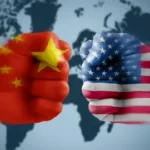Just weeks into President Trump’s latest round of tariffs, the White House has offered to talk. Yet China remains unmoved: no meaningful discussions until America rolls back its duties. That firm stance has left many wondering why Beijing seems to be winning this trade battle.
Calm Resolve in the Eye of the Tariff Storm
When a powerful storm hits, its center can feel oddly peaceful. China’s foreign ministry likened recent events to that “eye of the storm” — a quiet spot surrounded by chaos. While the U.S. has slapped on punishing duties, Beijing has resisted panic. Rather than lash out wildly, China has met each American levy with measured responses: matching some tariffs, taking its case to the World Trade Organization, and limiting exports of key minerals used in high-end electronics.
Holding the Line Until Tariffs Are Lifted
China’s message is simple: we’ll negotiate with you, but not under fire. By refusing to even sit down until tariffs come off, Beijing flips the script on Washington. Rather than chasing America’s changing demands, China forces the U.S. to make the first move. That gives Beijing the diplomatic upper hand and keeps American producers painfully aware of the cost of their own policies.
Domestic Pressure and National Pride
Inside China, photo after photo of empty store shelves stoked public anger — not at Beijing, but at Washington. Social media buzzed with criticism of the U.S. for blaming China when jobs and prices in America were at fault. That national indignation has strengthened President Xi Jinping’s hand, letting him present a tough posture abroad as a point of pride at home.
Washington’s Hidden Weaknesses
Back in the U.S., executives at big chains like Walmart and Target privately warned the White House that steep tariffs would mean empty shelves and higher prices. A stock market wobble, a frustrated electorate, and midterm elections just around the corner have added to Washington’s worries. If American leaders can’t point to quick gains, public pressure may force them to backtrack — exactly the sort of retreat Beijing hopes to trigger.
A Catalyst for China’s Own Reforms
Ironically, Trump’s trade offensive is pushing China to fix long-standing weaknesses. Tightening supply chains spurred Beijing’s “dual circulation” policy: encouraging people to buy more locally and funding electric cars, solar farms, and other green projects. At the same time, concerns about imported technology have driven record investment in homegrown research — from artificial intelligence and quantum computing to new semiconductor factories and rare-earth mining.
Building a New Global Network
While holding firm with the U.S., China is widening its circle of friends. It’s poured energy into deepening ties with Europe, Japan, South Korea, and the nations of Southeast Asia. It’s also revisiting talks with Canada and Australia, inviting them to push back against American “bullying.” On the multilateral stage, Beijing champions initiatives like BRICS, the Regional Comprehensive Economic Partnership, and its Belt and Road infrastructure plans — all alternatives to the post–World War II institutions long dominated by Washington.
Waiting Out the Storm
None of this guarantees victory for China. A full-blown, long-lasting disagreement could still dent China’s growth and shake consumer confidence. But by combining a steady defense at home with a charm offensive abroad, Beijing has placed itself in a position of strength. Meanwhile, America’s leaders juggle domestic politics, market jitters, and a deadline of election season.
What Comes Next
If Trump wants a deal, he may have to swallow his pride and meet China on Beijing’s terms. Otherwise, he risks letting this trade war drag into a second year — with higher prices in U.S. homes, tighter supply lines for American factories, and a Chinese economy growing more self‑reliant by the day.
In this clash of tariffs and talk, China isn’t just defending its interests. It’s quietly reshaping the rules of global trade and building an economic network that could outlast any one U.S. administration. And for now, that gives Beijing the clear advantage.
Read Also: European Gas Rises as Potential for US-China Talks Lifts Markets






